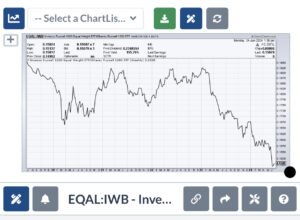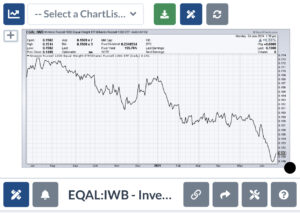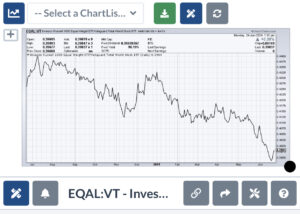The Magnificent One
The stock market has been infamously narrow, the famous Magnificent 7 having levitated the broad cap weighted indices while the rest have languished. More recently the Mag 7 have retreated into the Mag 1, as last week Nvidia shot past Apple and Microsoft to become the world’s largest company by stock market cap.
There are all kinds of ways to measure market breadth. A Financology favorite is to compare a broad equal weighted index with its cap weighted counterpart. Let’s take a look at StockCharts’ rendition of the equal weighted Russell 1000 versus the cap weighted Russell 1000 using ETF proxies:

This is a five year chart, showing that this narrowing is nothing new, dating back at least to the beginning of 2023. Although as we can plainly see by zooming in to one year, it has accelerated more recently.

It’s not confined to the US, either. This next chart is of the same equal weighted Russell 1000 versus the FTSE All World All Cap. It’s not a stretch to say that just one stock has been an Atlas holding up the entire world.

What about the investment implications? Is it turtles all the way down? Or does the market edifice ultimately rest on something more substantial? Or to put it more concretely, is this historic divergence more likely to be closed by the top collapsing, or will the left behind get a catch up?
Neither outcome is as certain as the likelihood that, one way or the other, the gap will revert. We have seen evidence of the latter in recent trading, as the Dow 30 and Russell 2000 rally today while the NASDAQ goes limp. We can see beginnings of reversion in the charts above. This tempts me to view the broad market in relation to the narrow market similarly to my take on China a few months ago, as a buying opportunity.
But as with most things in markets, as in life, there are no guarantees. The better perspective then, is that most portfolios are going to have stocks anyway, and to view this market setup as not whether or even how much to have in stocks, but how to weigh within the asset class. Heavy reliance on cap weighted exposure is likely to be inferior to a flatter allocation. The Financology Income Portfolios for example weigh stocks more according to fundamentals than market cap. Generally this and others like it that incidentally or even deliberately underweight high flying teracaps look compelling as ever.
But what if … maybe … what if, in the bigger picture, this is just the beginning of a new era, in which a few super big companies are en route to taking over the world? I confess to such dark thoughts having invaded my consciousness on occasion, and of course couldn’t rule something like that out. But that’s just about what it would take to justify current valuations of the high altitude elite. For a thoughtful discussion of the fundamentals regarding stock performance by market cap, see
Is Small Cap Exposure Still a Good Idea? Asking for a Friend …
If I’m not mistaken Nvidia was the highest cap stock for 1 day. Cisco did the same thing once upon a time
Right; I just didn’t elaborate because the post isn’t about Nvidia, as a casual glance beyond the first paragraph would indicate.
just expressing my skepticism [which i’m sure you share] about the mag 7 [4? 1?] taking over the world. they’re putting many billions into ai now, and it’s not at all clear how or when they’ll get some return on that investment. in the late 1990’s everyone was sure the internet would change the world, and they were right. otoh, the winners were not nearly as obvious as people thought.
Yes, although getting that impression would be forgivable. You can hardly turn around in a closet these days without encountering Alphabet, Amazon, Apple, Microsoft or Meta. They have become so big it’s almost as if the world has been growing a new government. They certainly make the rules by which a massive share of global commerce and communication take place.
AI doesn’t exactly appear poised to relieve that. Remember when information wanted to be free? And how the internet was going to make it happen? It was going to democratize the flow of information. For a while it did, but then was taken over by a handful of powerful corporations.
As I see it the real and present danger of AI isn’t that it will itself turn on the human race, but that it will even further concentrate wealth and power among the already wealthy and powerful. That AI will be of the few, by the few, and for the few.
Turning back to the investment implications, this cadre of ultracap corps, if it does not take over the world, is a poor investment, for its valuations imply that it will. To take the poster child du jour for example, Nvidia is trading in the vicinity of twenty times next year’s anticipated revenues. What cash flows can investors expect to receive? Dividends are a tiny fraction of revenues, and even assuming they grew at 50% per annum, it would take years for these discounted cash flows to come anywhere near returning its current price. Which would require a near total absence of competition or saturation while it grows to subsume a plurality of global GDP. In short, it and its hypercap brethren would have to take over the world.
And since they so dominate the stock market capitalization, investors indexed to it are effectively invested in that outcome. They need to ask themselves: Do I think they will take over the world? If not, should I consider a flatter, more fundamentally based allocation?
don’t know if you want to publish this, but some readers may not have come across scott mcneely’s renowned “what were you thinking?” rant about sun microsystems selling for a mere 10x actual revenues, compared to nvidia at 20x ESTIMATED revenues:
.
“At 10 times revenues, to give you a 10-year payback, I have to pay you 100% of revenues for 10 straight years in dividends. That assumes I can get that by my shareholders. That assumes I have zero cost of goods sold, which is very hard for a computer company. That assumes zero expenses, which is really hard with 39,000 employees. That assumes I pay no taxes, which is very hard. And that assumes you pay no taxes on your dividends, which is kind of illegal. And that assumes with zero R&D for the next 10 years, I can maintain the current revenue run rate. Now, having done that, would any of you like to buy my stock at USD64? Do you realize how ridiculous those basic assumptions are? You don’t need any transparency. You don’t need any footnotes. What were you thinking?”
– Scott McNeely, Founder and CEO of Sun Microsystems
Sure, why not. It’s been over a year since we last cited it, and it’s now more relevant not only than then but probably than at any time since McNeely said it.
There’s a regular feature to these things. Investors seize on a story. It’s a credible and compelling story, and is easily covered by the media. But they overlook the math, the part that informs about how much a stock should be worth. The math eventually wins, but things like discounted cash flow don’t make for breezy reporting and lack emotional charge. McNeely’s quip is about as close as you can get to putting the math in narrative form.
Another good article on this point:
https://www.advisorperspectives.com/commentaries/2024/07/03/morro-the-same-mark-oelschlager
a significant chunk of nvidia’s sales are to a company called coreweave. nvidia is an investor in coreweave, and offers it vendor financing. i.e. nvidia “lends” coreweave billions of dollars [literally] which coreweave uses to buy nvidia chips, i.e. the money roundtrips back to nvidia as “income.” the “loan” to coreweave is collateralized by the chips themselves, which i suppose are not depreciating.
.
via perplexity: CoreWeave is estimated to have been Nvidia’s 7th largest customer of H100 GPUs in 2023, purchasing approximately 40,000 of these processors. This purchase is estimated to account for about 4.5% of Nvidia’s total revenues for that period.
.
also via perplexity: Nvidia reported revenue of $26.04 billion for the fiscal first quarter, which exceeded analysts’ estimates by nearly $1.5 billion.
This represents a beat of approximately 6.1% compared to Wall Street’s expectations ($26.04 billion actual vs. $24.54 billion expected).
.
i.e. ~3/4 of nvidia’s “beat” consisted of “sales” to coreweave.
Don’t look now, but breadth suddenly exploded this week, with the Dow 30 and Russell 2000 soaring higher. So indeed we have already seen some of my predicted gap reversion. The catalyst was apparently a “tame” CPI print feeding fears (most reporters call it “hopes”, but that’s a value judgment, so why can’t I slip mine in?) the Fed may slash rates as soon as September.
Just desire to say your article is as amazing.
The clearness in your post is simply spectacular and i can assume you’re an expert on this subject.
Well with your permission allow me to grab your feed to keep up to date with
forthcoming post. Thanks a million and please keep up the gratifying work.
helloI really like your writing so a lot share we keep up a correspondence extra approximately your post on AOL I need an expert in this house to unravel my problem May be that is you Taking a look ahead to see you